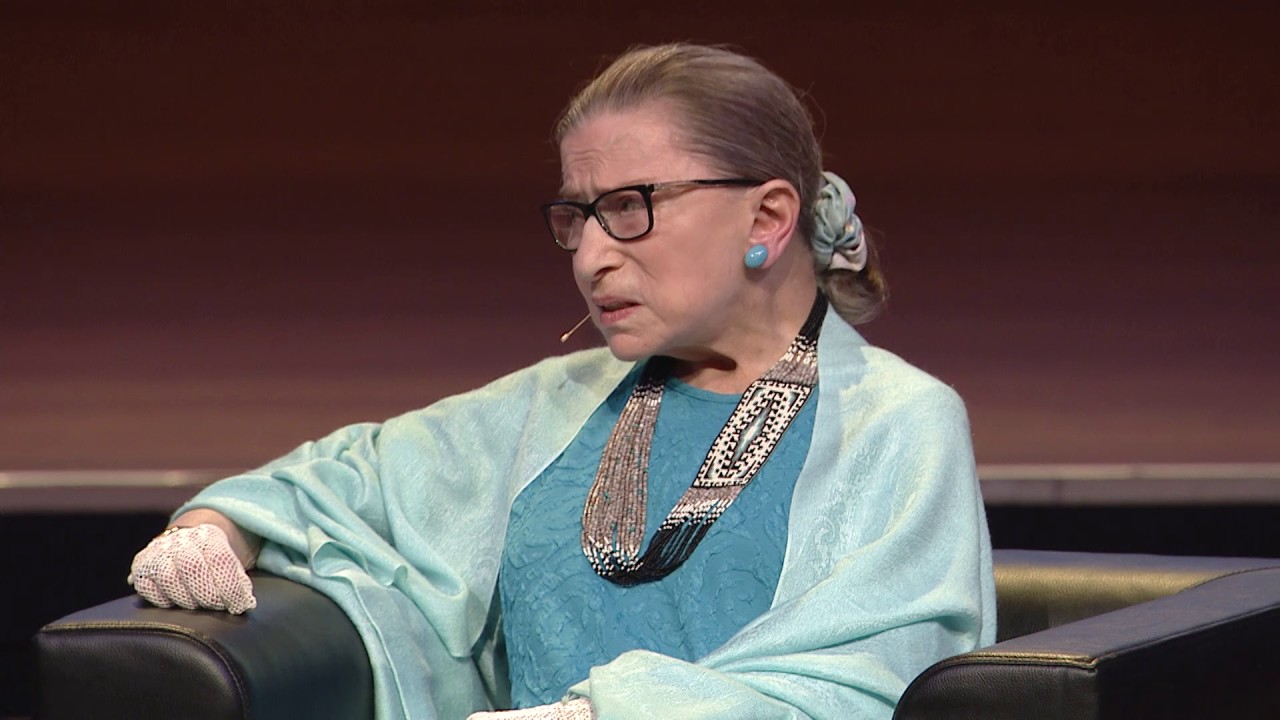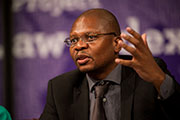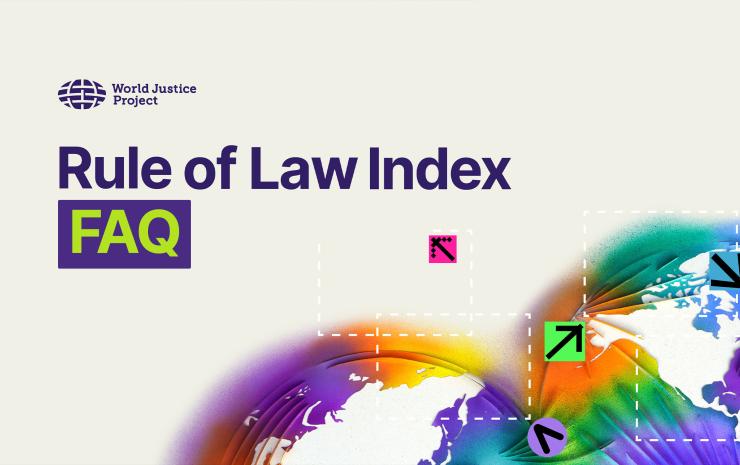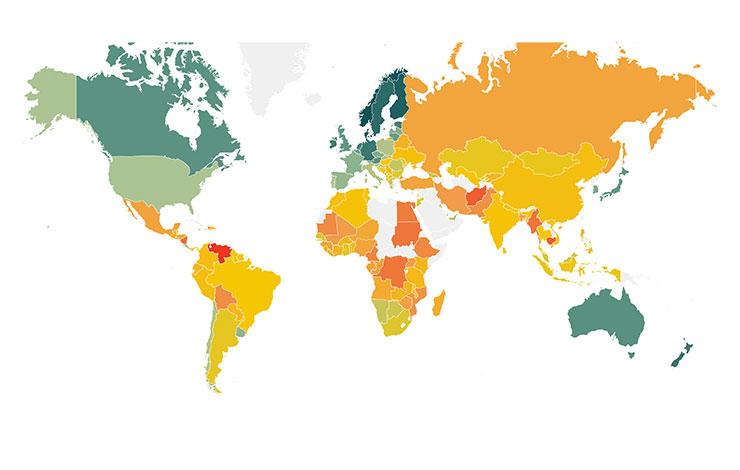

U.S. Supreme Court Justice Ruth Bader Ginsburg was an exceptional lawyer, judge, and trailblazing advocate for women’s rights, in addition to being an honorary chair of the World Justice Project, where she has served as an inspiration for building the rule of law movement.
In June, the World Justice Project honored her legacy at the 2022 World Justice Forum, with the first Ruth Bader Ginsburg Legacy Keynote Conversation. The featured speaker was Sherrilyn Ifill, a prominent American civil rights lawyer and inspirational advocate who is president and director-counsel emeritus of the NAACP Legal Defense Fund.
Before a wide-ranging conversation with CIVICUS Secretary General Lysa John, Ifill delivered the keynote remarks below.
Watch the Ruth Bader Ginsburg Legacy Conversation, moderated by CIVICUS Secretary General Lysa John.
When Justice Ginsburg passed away on September 18, 2020, I was devastated. It had already been one of the most challenging years of my professional life. The organization I led since 2013, the NAACP Legal Defense Fund (LDF), was in a battle to protect the rights of Black individuals, families, and communities.
During the final year of the Trump administration, our work focused on ensuring the right of every eligible Black citizen to vote, protecting educational access, ensuring economic justice for Black families and communities, and addressing racism in the criminal justice system. This has been the work of the organization since 1940, when it was founded by the legendary civil rights lawyer Thurgood Marshall, who with his team at the LDF, essentially created the field of what we call civil rights law in the U.S.
In 2020, there were two uniquely difficult challenges to our work protecting the rights of minority communities—COVID and Donald Trump. So, when we heard in the early evening of September 18, just two months before the presidential elections that Justice Ginsburg had passed away, it was especially devastating.
"The [U.S. Supreme] Court lost its only remaining civil rights lawyer"
When I was asked what we would miss about her, I said that the court had lost its only remaining civil rights lawyer.
Ginsburg, I explained, was one of only two civil rights lawyers who have ever sat on the U.S. Supreme Court. The first was Thurgood Marshall, who became the first Black lawyer to sit on the Supreme Court. Marshall's work leading the LDF and successfully arguing before the U.S. Supreme Court hit its peak with Brown vs Board of Education in 1954, which for those of you who don’t know, began the end of legal apartheid in the U.S.—which was legal in the United States until 1954.
The case didn't end legal apartheid all at once, but it was a brick that once removed from the wall of discrimination began to crumble the legal framework that held up legalized racial discrimination in our country.
“A pioneer in the field of women’s rights law”
As a young lawyer, Justice Ginsburg followed Marshall’s template to pioneer the field of women's rights law in the U.S. She was often compared to Marshall, and she always reminded commentators that Marshall, a Black man had risked his life traveling through the South and litigating cases in some of the most violent days of white supremacy.
Ginsburg insisted she had never risked her life fighting for women's rights. She had been a victim of gender discrimination, of course, unable to obtain a job at a law firm despite her impressive performance in law school. But she ended up teaching law and created a project at the ACLU devoted to fighting for women's rights.
Ginsburg always admitted to using the strategy patented by Marshall of painstakingly filing and litigating cases that would strike blows at the legal foundations of discrimination until it could no longer be sustained. One of the things I loved about Justice Ginsburg was that in addition to crediting the strategy of Marshall, she also credited the intellectual and strategic contributions of Pauli Murray, a Black woman lawyer whose own confrontation with race, gender, and sexual orientation discrimination fueled her critical contributions to Marshall and Ginsburg’s work.
As former civil rights lawyers, Marshall and Ginsburg brought something unique and critical to the Supreme Court and to our understanding of the rule of law. It's important to identify this in my view, because we are in a moment when the rule of law is challenged around the world.
“The rule of law means that the law is not used to control the powerless”
In the U.S., there is deep skepticism, among many in the communities of people I represent to the concept of the rule of law. They often see it as a suspect concept, which in their view locks in the status quo of inequality and excludes the truth about the law as it manifests in the lives of those who live at the margins of our society.
Far too often, the law has been an instrument of oppression. When I talk about the rule of law, I refer to principles that the law applies equally to all the powerful and the powerless that it secures procedural as well as substantive justice, that crimes of corruption of obstruction of justice, witness tampering, conspiracy, or racketeering must be prosecuted.
The rule of law means that we do not abuse legal power by shielding our friends from the legal consequences to which we would expose our enemies.
The rule of law means that the law is not used to control the powerless or to further enrich the powerful. The rule of law demands accountability for those who break the law and assigns heightened responsibility to those with the obligation to uphold and enforce the law.
The rule of law requires transparency and consistency in the decisions of our courts, especially our highest courts, which must set an example by operating with as much transparency as possible and must be willing to bind itself to ethical standards and to decision making, which is anchored in written explanations so that the public can understand why the court does what it does. Justice Ginsburg was especially zealous about the importance of an independent judiciary to the rule of law.
Justice Ginsburg, like Justice Marshall, brought another dimension to thinking about the rule of law. And this is what we will miss most because of her experience, which was as a practicing lawyer, Ginsburg was acutely aware of how gender discrimination manifested itself in the lives of women—that discrimination is not just what the law says, but how it works in a society dominated by ideas of male superiority. This awareness and insistence on finding opportunities to educate her colleagues and the public about this legal reality for women compelled a more complex understanding of the rule of law.
“She believed the lived experiences of the law should have a place at the table”
In 2006, Justice Ginsburg offered a dissent from a majority opinion in a case called Ledbetter vs Goodyear Tire. The case involved a woman named Lily Ledbetter, who had worked at the tire plant for 20 years. She was unaware that her male counterparts in the same job as her were being paid substantially more until she saw a colleague's pay stub.
The question in the case focused on whether the back pay she was owed should include the period only after which she learned of the paid disparity, or should it include the period before.
In the end, the court held that Ms. Ledbetter could not recover damages for the period that the pay disparity was unknown to her. Justice Ginsburg's dissent, which she explained later was directed at Congress, explained to the court and to the country just how pay disparity often operates in the workplace.
Months later, Congress passed the Lily Ledbetter Equal Pay Act, and it became the first piece of legislation signed by President Barack Obama.
Time and again, her opinions made clear that she believed that the lived experience of the law should have a place at the table. When Justice Marshall retired, many of his colleagues, including those with which he was often most diametrically opposed, wrote that Marshall told them things they did not know by virtue of their experience and things that they perhaps would rather forget.
Marshall's stories about coerced confessions from Black men by Southern sheriffs, about Black people excluded from juries, about the way the death penalty is muted out along racial lines. These stories were critical ingredients to adjust application of the principles of the rule of law in a society, in which vast inequality is deeply embedded in traditions and legal systems.
The rule of law must be guided and framed by an understanding of how the law works in the lives of those most marginalized.
“What encourages me”
Justice Ginsburg, like Justice Marshall, brought this sensibility to her understanding and application of the law and set an example for other judges to do so. It is that personal experience up close with this reality and the authenticity that comes from litigating on behalf of those contending with inequalities that is now missing from the Supreme Court, where most justices formerly served as prosecutors or political appointees.
We hope that Ketanji Brown Jackson, who served for a brief period as a public defender and is herself, a Black woman, will bring her experience representing criminal defendants to the court's deliberations. We hope that she's not arriving too late.
There are troubling signs that our Supreme Court increasingly appears disinclined to thoughtfully consider these truths to add to their understanding of the law. And so those of us who are civil rights lawyers and activists must keep pressing.
The rule of law is strengthened by an ecosystem that does not include just lawyers and legislators and litigants and judges. The ecosystem includes the work of community, activists and organizers. We know it's also shaped by economic cycles and global trends by war and peace, and by corruption and bribes, special interests, and ego.
But despite what are often the negative influences on that ecosystem, what encourages me is knowing how many of us represented by this extraordinary gathering are seeking to shape this ecosystem to uphold the integrity of the rule of law and to strengthen the law's ability to dispense, not just law, but justice.
Sherrilyn Ifill was the keynote speaker during the inaugural Ruth Bader Ginsburg Legacy Conversation at the 2022 World Justice Forum.






